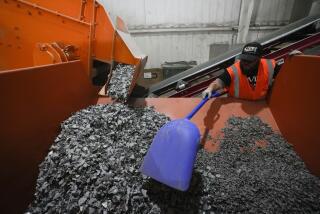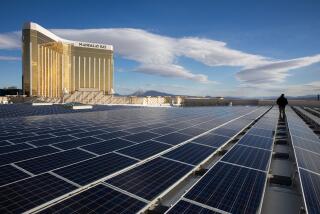Production Costs Ground Maker of Solar Cells : Technology: A City of Industry firm has a lock on a new, better type of cell to power satellites, but tightening government budgets are having an impact on sales.
High above Earth, more and more satellites are being powered by gallium arsenide solar cells--cells that are lighter, longer-lasting and more efficient than any made from silicon, the industry standard.
Ninety-nine percent of the market for gallium arsenide solar cells belongs to Applied Solar Energy Corp., a solar and optical technologies firm based in the City of Industry, which has placed its business future behind the compound semiconductor material. But geo-political and economic realities have dropped the firm’s sky-high hopes down to Earth.
Though the company has a lock on the technology to mass-produce gallium arsenide cells--acknowledged by industry analysts as a better product--production costs are blocking its widespread use. So, for Applied Solar, the payoff for nearly 10 years of research and development remains elusive.
Congressional wrangling over the price tag of the controversial space station Freedom delivered a blow to the solar firm last August when it was announced that two major contracts with Applied Solar would be canceled.
Cost-conscious planners at Lockheed, in charge of building the station’s solar arrays, passed over gallium arsenide for less-expensive silicon cells. Applied Solar, which still receives 20% of its annual revenue from silicon cells, won part of the silicon contracts, sharing it with Spectrolab, a Sylmar-based subsidiary of Hughes Aircraft. But when NASA cost-cutting finally reached the solar cell level, both companies were forced to rebid and Spectrolab won.
According to Gerard McLarnon, Applied Solar’s president and chief executive, the cost of the two NASA contracts combined will amount to a possible $40 million in lost revenue for his company over the next six or seven years.
Steve DeBrock, the solar array program manager for Lockheed, said the decision to go with one company on the project was due to the large cut in cell orders. He refused to release the bidding figures, but said Spectrolab’s rebid was “at least 10% less” than Applied Solar’s.
McLarnon said he wasn’t surprised by Lockheed’s decision, since the bad news was foreshadowed by the political budget slashing in Washington, which cut billions from the ambitious project.
“There are no instant, overnight decisions in the space business,” he said.
Applied Solar, which employs more than 240 workers, produces solar cells primarily for aerospace firms that rely on government contracts--contracts that are shrinking as politicians attempt to divert defense and space exploration money to other concerns.
To seemingly make matters more uncertain, Applied Solar is in the process of being sold to Costa Mesa-based Westar Capital, an investment firm owned by a Southern California real estate developer. Westar will pay more than $20 million in stock purchases and debt payments for Applied Solar, according to Greg Delgado, a senior Westar representative. The stock transfer gained Security Exchange Commission approval Feb. 6 and the terms of the buyout were made public Feb. 10.
Delgado gave assurances that Westar will support Applied Solar’s continued efforts in gallium arsenide and encourage the high-tech firm to develop even more sophisticated solar technologies for use on satellites and other space vehicles.
McLarnon described Westar as more “bottom-line oriented” than American Cyanamid, the company’s previous owners, but expressed little concern about the acquisition.
“They want a return on their investment,” he said of Westar. “But you can anticipate a long-term perspective from the new owner.”
McLarnon, who expects to leave when Westar puts its new management team in place, predicted that the new owner will probably sell Applied Solar’s solid state laser and photosensor divisions, but keep some interest in the two because they are housed in the same 148,400-square-foot facility and are interrelated with the solar cell operation.
The company reported more than $27 million in total revenue in fiscal year 1991, but suffered a net loss of $313,000. The loss of the two space station contracts will begin to affect the company this year, McLarnon acknowledged.
However, he remains optimistic about the company’s outlook.
The Gulf war, he said, impressed upon military planners the need for added and more sophisticated satellites. The departments of Defense and Energy last year placed gallium arsenide, which also has applications in the computer field, on its list of 22 technologies critical to national security and the long-term superiority of U.S.
Also, McLarnon suggested, commercial satellite orders may surge dramatically with the implementation of major projects such as a $3.2-billion Motorola program that will launch 77 satellites for a worldwide cellular telephone network.
On the drawing boards for NASA is the Earth Observation System, a multibillion-dollar project that will employ 10 to 12 space platforms to monitor the planet’s environment. General Electric, the systems chief contractor, may decide to go with gallium arsenide cells once plans are finalized, DeBrock said.
With that in mind, McLarnon said, “we’re predicting substantial growth from late 1993 onward.”
DeBrock added that gallium arsenide could still be used on the space station project, of which the first phase is set for launch in mid-1995.
“If it turns out that the station needs more power, there’s nothing to say I would need the same silicon cells,” DeBrock offered.
NASA planners, according to DeBrock, opted to pay less and go with silicon because gallium arsenide on a project as large as the space station would be prohibitive.
Gallium arsenide cells bought in mass quantities can cost up to $400 a piece, while a comparable silicon cells cost about $50. The space station, as it is now conceived, will require two-thirds of an acre of solar cells, DeBrock pointed out. A gallium arsenide array would simply be far too expensive at current prices.
DeBrock, though, foresees gallium arsenide eventually dominating the satellite market. “I see gallium arsenide coming on like gangbusters,” he said.
Already, makers of advanced satellites, including military satellites, find gallium arsenide invaluable and the way of the future, McLarnon said. The technology was developed in 1982 by Applied Solar with money from the Air Force.
Japanese firms such as Mitsubishi and Sharp are developing their own versions of gallium arsenide technology, but “they’re way behind us,” McLarnon said. “If it’s not fumbled by government regulation or something, we should stay in the lead.”
More to Read
Inside the business of entertainment
The Wide Shot brings you news, analysis and insights on everything from streaming wars to production — and what it all means for the future.
You may occasionally receive promotional content from the Los Angeles Times.










